One of the greatest testaments to human brilliance is located in the city of Istanbul, Turkey. Completed in 537 A.D., the Hagia Sophia was built to be the greatest church on earth by one of the Roman Empire’s most ambitious and controversial Emperors. In a recent post, I told the story of the city of Istanbul. As I had traveled there very recently after nearly two decades of waiting, I was excited to share my wonder for the place. However, throughout that post I omitted any discussion of the Hagia Sophia, which is the building that convinced me to visit the city when I was just 10 years old. I admire that building and those who built it, and the story leading up to it’s construction captivated me. It still does! I thought that it deserved it’s own uninterrupted story; but to tell it, I’ll need to tell you about the extremely violent sport of chariot racing, about a blood thirsty tyrannical Emperor, about massive riots and massacres, about engineering and scientific achievements, and about wars of conquest. This building has been through a lot.
Our story begins in 532 A.D. on a particular day at the Hippodrome of Constantinople, where some chariot races were taking place. Throughout the Roman Empire, public sports were perhaps even more popular than they are today. That is a bold statement, considering how seriously they are taken today, and by how many. But to make a point, back then, the world’s population was a lot smaller, but their stadiums were often just as big as they are today! We all know of Rome’s Colosseum and of gladiatorial games, but at this point in time, the most important sport in the empire was that of chariot racing. These races were held in hippodromes, where two long parallel tracks were tied together by semi circles at either end. In the hippodrome of Constantinople (now Istanbul), up to 100,000 people might be in attendance at once. But to give some perspective on how big these games could get; in the Circus Maximus of Rome, arguably the largest hippodrome ever built, around 250,000 people might have been able to attend; a quarter of Rome’s population at that time. Consider your local stadium, does it compare to what Rome could offer it’s people 2000 years ago?
As with most things that existed in antiquity, chariot racing is very little understood. So much is unknown to us about how it was organized, how the races went, and most of what we do know comes from poems and from mosaics and paintings. In the poems, we get wonderful imagery, describing the feeling of being at one of these games, but nothing is said about how the games were played. This is a common problem in history, because just like us today, people in the past took their world for granted. No one felt the need to describe something in detail that literally everyone understood very well. Ask yourself this: if you knew nothing about the sports common in the country you live in, but you could read the text messages exchanged between two of your friends about a match that they witnessed; could you guess at the rules of that sport? Chances are you wouldn’t even know that hockey was played on ice if you only had the correspondence between two fans to look at. That’s why history is such a puzzle sometimes. But back to the point; Chariot Races.
Our ancient poets nevertheless give us a wealth of information. Races normally figured teams of two or four horses, and depending on the arena, there could be up to twelve chariots racing at once. They tell us that the games were brutal, and that there were few rules; in other words, racing was violent. Some of the standard strategies in these races included striking horses and other drivers with whips and fists, slamming chariots into others, cutting off opponents and driving opponents into walls. Charioteers almost always started off as slaves, usually made to start racing around the age of 9 years old, and if they were successful, they could be freed and become fabulously wealthy. Moreover, these were some of most famous men alive in their world. Much like today, where everyone has heard of Michael Jordan and Muhammad Ali, these charioteers could be better known than those ruling the nation. The same can be said of the horses. Though race days were horrific and brutal for these animals, their time in stables were made up of unbridled luxury. Horses were loved by crowds as much as were the drivers, and horses that won 100 races were publicly honored. But to be clear, crashes were part of the fun for the audiences. This was a blood sport as much as a competition, and pile ups involving many numbers of chariots were lovingly refereed to as Shipwrecks. We’re strange, aren’t we?
Did you know: The highest paid athlete of all history is considered to be Gaius Appuleius Diocles, a chariot racer who is estimated to have earned over 15 billion $ in today’s money. Compare this to the next in line; Michael Jordan is estimated to have earned 1.9 billion.
In this city, there were four main chariot teams: the Blues, the Reds, the Greens, and the Whites. Audience members supported their favorite team by wearing jerseys of corresponding color, much like today. But these teams and their fans weren’t like any sports associations you might see nowadays; these teams were the equivalent of political factions that brought together masses of civilians with street thugs and politicians. They had power. Normally they fought one another, but alliances and coalitions were common.
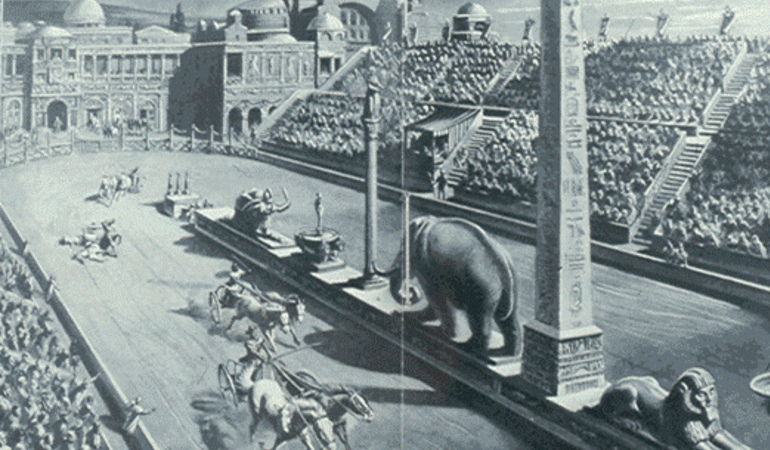
At this moment, Constantinople was in an uproar, and everyone was furious with Emperor Justinian I. This emperor had been born a peasant, and had risen up to the greatest position of power existing in Europe at that time; needless to say, he was an astonishingly energetic man, and once he bore the mantle of empire, he set himself on making changes. He had a war to end with the Persian Sassanids, so he raised taxes. Next he went after all that he considered immoral; also known as fun stuff. He tried to eliminate all old pagan religious ceremonies, the study of ancient philosophers, adultery, prostitution, Christians that had different opinions, homosexuality, and the Jews. People didn’t like that, and all these people suddenly felt a little enemy of my enemy is my friend. These chariot races became the focal points from which their discontent was manifested. The greatest place that the citizens of Constantinople had to gather together was the Hippodrome, and the Emperor often attended from his palace balcony, which was integrated in the design of the hippodrome.
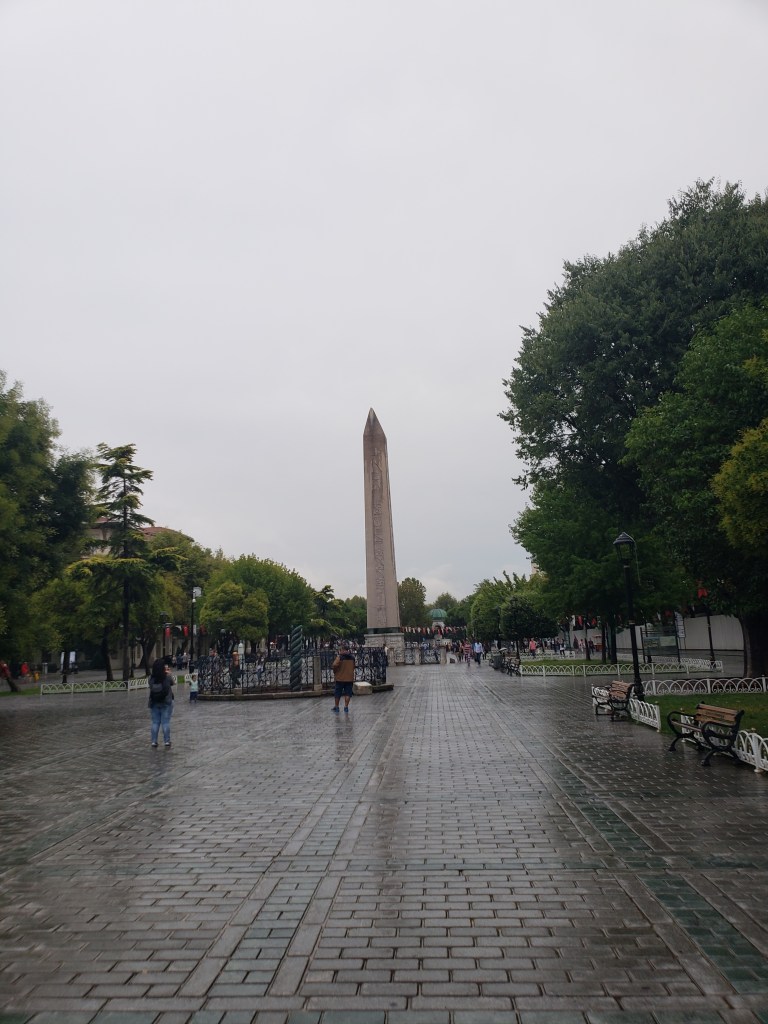
One day, the normally opposed teams and fans came together and begun to chant a slogan towards the palace to voice their resentment. Nika; win, they chanted! These crowds were legendarily chaotic, but on this day, they rampaged into the streets, set fire to buildings, and besieged the Emperor in his palace for five days. Moreover, the politicians and aristocrats in the city saw this as a perfect opportunity to try to overthrow their Emperor. This was a perfect storm, and it is likely that the politicians had conspired through their team affiliations to make it happen this way. The ambitious emperor was stunned. We are told that he thought about running away; but no peasant that ever made himself emperor should be underestimated. He also had a pretty ruthless wife.
On the fifth day, Justinian sent soldiers to the Hippodrome, where the teams and rioters had been assembled in a pretense, that the emperor was willing to compromise and would meet them. There, under the leadership of the general Belisarius, loyal to his emperor, soldiers barricaded the stadium, entered in formation, and went to work killing every last man. It is said that 30,000 were killed in that place. By hand.
The Nika Riots, as they would come to be known, were over. In less than a week, half the city had burned to ashes, most of the population had been displaced, and tens of thousands had died. This was the greatest riot that this city ever faced in its history. However, now that Justinian’s power was uncontested, he was intent to show his people that he was worth the blood he had taken from them. He first sent armies west under the leadership of Belisarius. Though his promotion to commander of the western push was a reward for loyalty shown at Nika, it would eventually turn into a curse, for he had the monumental responsibility to reconstitute the old Roman Empire, which had fallen on dark times by now. Most of the Western Empire was now under the control of various conquering hoards. But the astonishing campaigns and bittersweet achievements of Belisarius are a subject for another post.

In addition to setting out to fight wars of reconquest, Justinian began a series of monumental building projects to cement his authority. Nothing say’s I’m in charge like I paid for that. One of these would be the crowning jewel of Justinian’s legacy. The city’s Cathedral had been burned down during the riots, and Justinian would build the city a new basilica on the site of the old one. A devout Christian, Justinian decided that his engineers would build the greatest Church in the world. Perhaps he felt as though he had some things to atone for. The fact is that Justinian was not so different from other Roman Emperors, or to other leaders all around the world at that time; dissent was crushed however it needed to be. Today we do that too, just more cleanly; we just throw tear gas at it and hope it goes away. Regardless, today we don’t remember Justinian for his ruthlessness, but for his building programs, which are still visible in their glory.
He tasked two professors of mathematics and physics with no experience in construction, Isidorus and Anthemius, with building the church. He only had two demands; that they build it very quickly, and that the building should be completely different from anything preceding it. Under pressure from a murderous emperor, the two set to work. After just six weeks, the two had a design and had begun constructing the largest building in the world. Forget how long it takes to begin construction anywhere in our day in age for a small building, Justinian was throwing all that was needed at this project, from slaves to materials. Interestingly, upon my own visit to the Hagia Sophia, I asked my guide why there were so many different types of columns in the church, and he answered that the builders had recycled many columns from older sites within the empire to cut down on the time to manufacture new ones, and since this church was so big, no single other location had sufficient matching columns to fulfill its building needs.
The dome was another special feature in this building. It would be 100 feet across, about 33 meters, and the largest masonry dome in the world; and therefore extremely heavy, which is a major concern in building. The engineers would need to become very crafty in constructing this structure, because should the weight of the dome be badly distributed, the dome, or the building supporting the dome, would collapse.
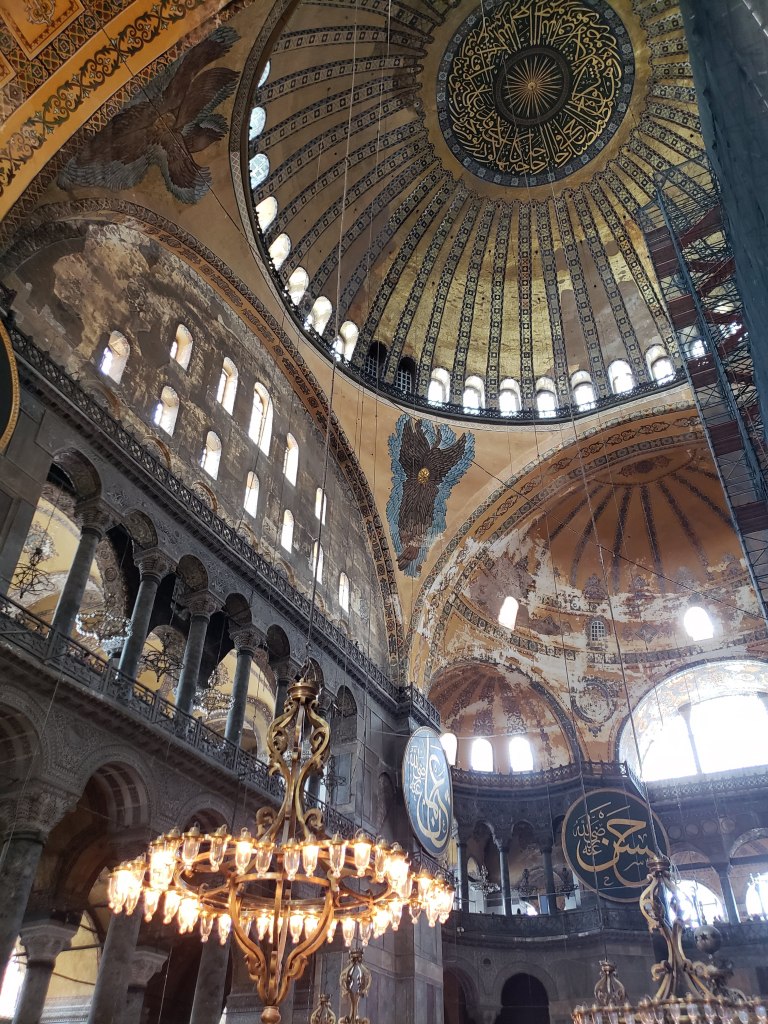
You have to imagine that the weight of the dome created a force that pushed directly down on its supports. That’s difficult enough to engineer at a height over 50 meters, but the nature of a dome’s shape creates horizontal outward forces upon the supports as well. Lateral shearing forces. Now the supports have to withstand the downward force but also the secondary sideways force, all created by the weight of the dome. Supporting the sideways force is commonly referred to as buttressing. To do this they relied upon architectural structures called pendentives, which help distribute the weight of the heavy dome downwards. These pendentives can be described as four roman arches set up in a square, as shown in the pictures below. Rounded arches were a very standard architectural solution to the distribution of building weight, and allowed for very tall stone and brick building projects in the ancient world. The pendentive brought this solution one step further.

Pendentives were commonly used during the roman era to support the weight of smaller domes, but these mathematician architects brought the technology to a new level; they decided that if one set of pendentives was good, then more had to be better. They began to combine pendentive structures, layering them away from each other, almost creating a giant brick hill. The end result was a central pendentive supporting the world’s biggest masonry dome, followed by rows and rows of smaller pendentives extending away. The picture bellow shows a midsection cut view of the Hagia Sophia, and shows well how all the layered pendentive structures support the centre of the church.

Picture taken from http://www.greatistanbul.com/
As you can tell from this picture, the engineering elements which meant to prop up the ancient dome came to determine its unusual and exotic architecture. Nothing like this existed before it, and after it, the style became an architectural standard for much of the East Mediterranean Religions. Just look around Istanbul today for evidence of that.
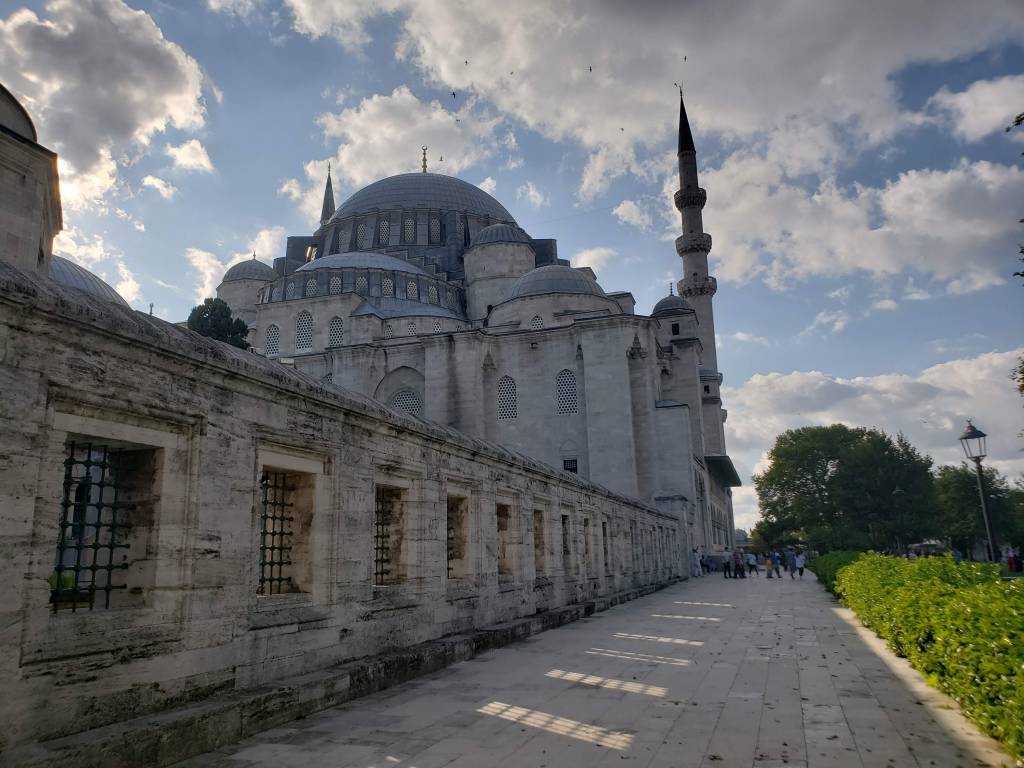
The construction of the church began in 532 A.D. It was completed in 537. This stunning construction time amazed all those that witnessed this site, but it probably also explains the fact that the dome collapsed in an earthquake in 558. The building had been built too quickly, and had some flaws. The dome had been too flat, which drove the weight disproportionately sideways, putting the buttressing ability of the pandentives beyond their limits. The new dome would be taller, and thus would drive its own weight as directly into the ground as possible. Since then the problem has been largely solved; however, another earthquake shifted the dome’s current alignment in the last few centuries. Guides in the Hagia Sofia like to bring tourists to the center point directly beneath the dome (it is indicated with a small X that was carved into the floor by Ottoman architects some 500 years ago, before this last earthquake) in order to point out that the displacement is visible. Indeed, a chandelier hangs directly from the centre of the dome and comes down from the ceiling to within 3 meters of the floor. It rests at least 50 cm away from the center mark in the floor.
But since 558, the same dome stands. In 565, Justinian would die and be remembered as Justinian the Great, and despite his amazing, bloody, and revolutionary life, this building is still the biggest reason that he is remembered today. Perhaps this is a lesson to any who would like to leave a mark on the world. No one remembers the name of those two architects nor those of any of the workers. I had to dig to find those. We only remember the name of the one who paid for it.
When the Hagia Sophia was built, it was the biggest building in the world, and it would remain the largest church in the world for nearly one thousand years. However, surprisingly it was not displaced as largest by the construction of a bigger church elsewhere. Those who read my previous article about Istanbul will know that in 1453, about 900 years after Justinian’s death, the city of Constantinople was conquered and occupied by a new empire; the Ottomans. Under the leadership of Mehmet II, troops had besieged the city for months before finally breaking into it by force of cannon.
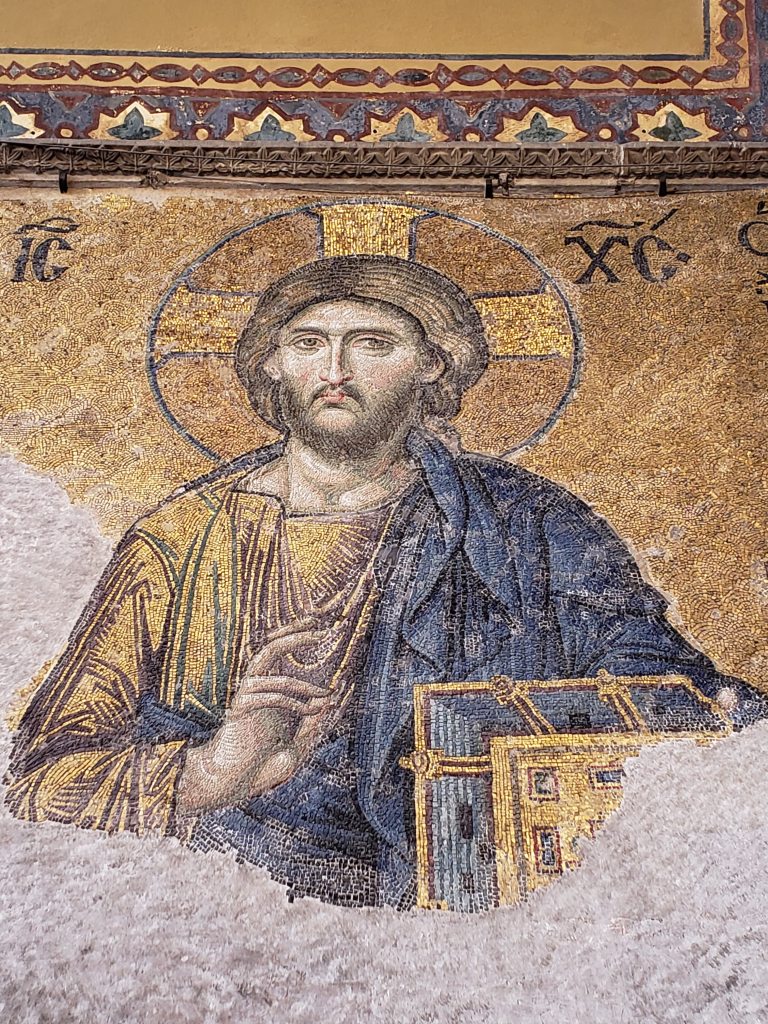
The Ottomans brought with them another religion that they would vigorously encourage in their empire; and yet the Hagia Sophia amazed the conquerors. Mehmet never even thought of tearing down this church. That was not standard practice at that time in history. The Ottomans were rather pragmatic, and converted the world’s biggest church into… just another mosque. Mosques were already really big. But I think many mosques dedicate quite a bit of room to open air sections that count towards this size calculation, whereas most churches don’t have significant open air spaces considered part of the church. Regardless, after World War One, the nation of Turkey was born, and its leader, Ataturk, converted the Hagia Sophia into a museum, as it still is today. However, upon opening the Hagia Sophia to the world as a museum, Ataturk also had the plaster covering the Christian symbolism removed. Naturally, the conquerors had covered up the Christian symbolism in the Hagia Sophia when they converted the church into a mosque. It is quite a blessing that they did not destroy it instead, because the Roman mosaics and paintings are beautiful. Today, the Hagia stands as one of the only buildings in the world to incorporate both Christian and Islamic symbolism in a harmonious manner, with the giant name of Muhammad and Allah framing a picture of Jesus and Mary on a throne.

Now I love this building. So much has happened around it, and if you could be a fly on the wall in a building like that through history you would gain such a significant sight into the past. My point is that, the building was so astonishing that it became a focal point for so many famous individuals, emperors, charioteers, generals, scholars, architects, slaves, peasants, worshippers, tourists, and people from all over the world at all times in history since it was built. The Romans who built this structure had an empire ranging from Egypt to the Balkans; you can be certain that individuals from all those places visited and spent time in this building. And then imagine all the visitors from the bordering regions.
One of my favorite stories about the Hagia Sophia involves graffiti. There are two places where there is runic graffiti in the Hagia Sophia. Runic was the writing style of people we think of as Vikings; what was it doing there?! This might be explained by the fact that the emperors of Constantinople were all protected by a legendary bodyguard made up of Norsemen, named the Varagian Guard. As part of a diplomatic agreement with the Norsemen that ruled the territories of modern-day Russia, the Emperor was protected by some Norse fighters sent from the north, who would come to be known as some of the best soldiers in the Mediterranean. Though hardy fighters, they lived up to their stereotypes; one story about them tells of a Norse leader visiting Constantinople; upon spending time with the guards, he gave them a speech in which he reprimanded them for drinking too heavily and being so rowdy. He told them that they should moderate their drinking to present a better image of the Norsemen. He said that to the personal body guards of the most powerful man in Europe.
Well, these men had to accompany the Emperor everywhere, even to church, and probably from one of these guards, bored on duty, maybe even hung over, we have the runic graffiti which reads : “Halfdan was here”. Carved into the Hagia Sophia.
Halfdan could have written that anywhere, but then none of us would have known about Halfdan. The Hagia Sophia, and the city of Istanbul, are great testaments to the collective achievements of humanity thus far; but they are also portals through which we can know our ancestors. I don’t want us to stop improving because we’ve done enough; but take a look a monument some day. A striking building, or perhaps even an ordinary one; pause and try to see time pass through it. Try to imagine all that might have happened there because someone decided to build something.
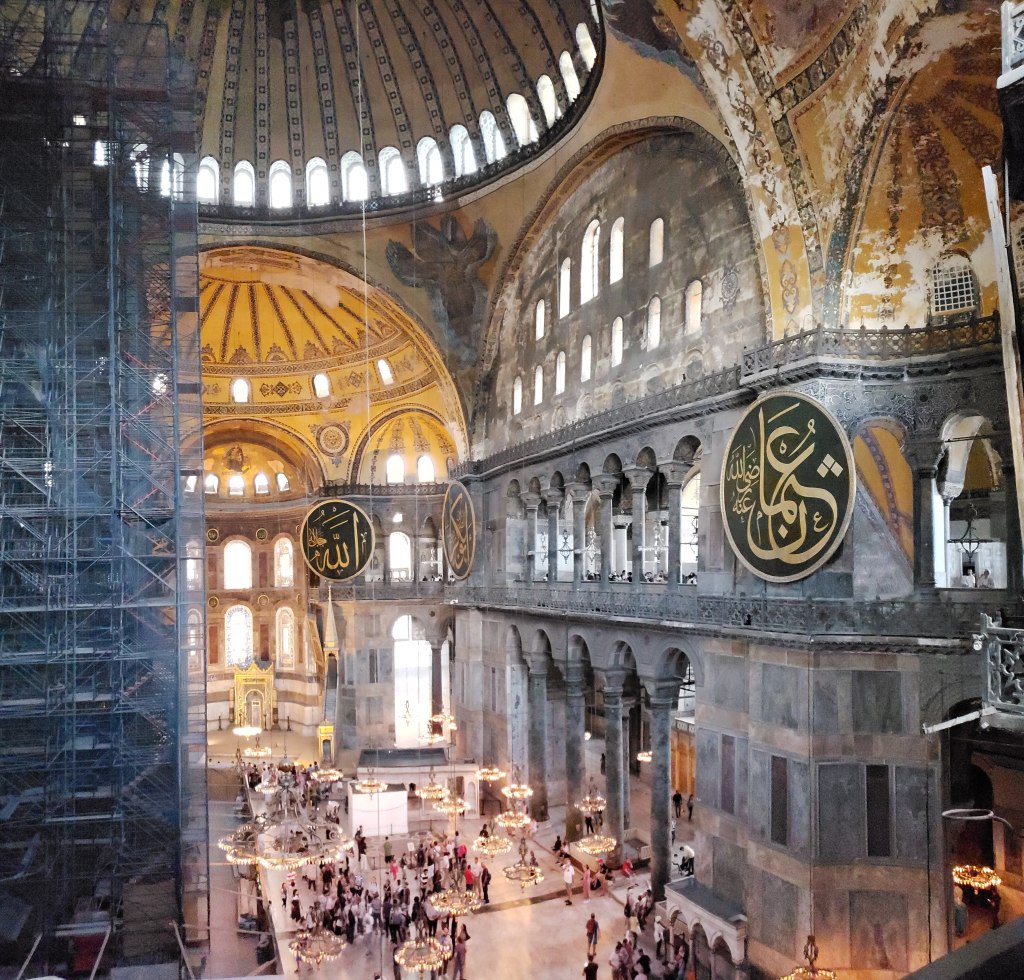
👍
LikeLike
Fascinating encompassing multi topic writing! Continue like this bro
LikeLiked by 1 person
Thank you my emperor!
LikeLike